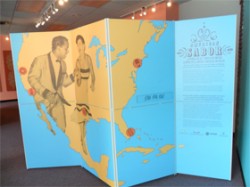By: Celia Martinez
 The once silent and empty retail space of U.S. Bank has been filled with vibrant imagery and music like salsa, tejano, norteñas and even punk and psychedelic as artists like Celia Cruz, Tito Puente, Selena, Los Tigeres del Norte and Carlos Santana, have come together to entertain and educate Chicagoans. Welcome to American Sabor, a Smithsonian traveling exhibit that explores the influence of Latinos in American popular music from the 1940’s to the present.
The once silent and empty retail space of U.S. Bank has been filled with vibrant imagery and music like salsa, tejano, norteñas and even punk and psychedelic as artists like Celia Cruz, Tito Puente, Selena, Los Tigeres del Norte and Carlos Santana, have come together to entertain and educate Chicagoans. Welcome to American Sabor, a Smithsonian traveling exhibit that explores the influence of Latinos in American popular music from the 1940’s to the present.
The exhibit is housed in U.S. Bank Exhibit Hall, 2958 N. Milwaukee, in Logan Square and houses a vivacious display of panels divided by cities and music, interactive media and even a jukebox. “I’m really excited to have this exhibit in Logan Square,” said Jorge Felix, studio arts and exhibit program coordinator for the Puerto Rican Arts Alliance (PRAA).
For over a year, PRAA worked tirelessly to bring this exhibit to Chicago in hopes of enlightening youth and perhaps even bring a sense of nostalgia. The early stages of planning began over a year a go when PRAA Executive Director, Carlos Hernandez brought the idea to Felix after learning that the exhibit would indeed begin a national tour. Hernandez saw it as a perfect opportunity to educate young and old alike.
“A lot of youth, and even older people in the Latino Community don’t know how Latin music came about in the United States and the impact that it’s had over the years,” said Hernandez. But bringing the exhibit to Chicago was no easy task. There was a lot planning and preparation involved especially when taking into consideration the logistics, such as space and location as well as the financial aspects.
“Originally we thought that the only way to bring this exhibit to Chicago was to take it to a mainstream venue,” said Felix. “But we wanted to make a statement and this is about Latino music and we thought that the best place to house this exhibit should be in the local community.”
PRAA found a great partner with U.S. Bank which had approximately 3,000 square footage of retail space available, just enough to be able to host this grand exhibit. Hernandez said there were many factors that lead to their decision of housing the exhibition there.
“This location is very important to us,” said Hernandez. “We chose is because it is right across the street from our brand new cultural center, secondly we positioned ourselves in Logan Square because of the growing Latino population; thirdly, U.S. Bank has been very generous to the organization and provided the entire state in-kind.”
PRAA also took into considered that the location should be easily accessible whether driving or taking public transportation. “We hope that we will be able to attract many of the Chicago residents and beyond Chicago to look at this exhibition and interact with it because there are interactive pieces,” Hernandez said. The interactive pieces include listening centers divided into four cities: San Antonio, San Francisco, Los Angeles and New York; a mixing station where individuals can explore different sounds and instruments and a jukebox with it’s own dance floor-what’s more interactive than that!
Felix hopes that it is these interactive pieces in the exhibit that attracts the youth and is encouraging elementary schools to bring their students as well as high school and college students to use the exhibit as a classroom. “The interactive [stations] really make it an exhibit perfect for youth, for young people to learn about how Latinos came to America and made a statement through music,” Felix said.










